Olinda Carnival is one of Brazil’s most vibrant and authentic celebrations, attracting travelers from all over the world. Unlike the glamorous parades of Rio de Janeiro or the massive street parties of Salvador, the Carnival in Olinda is famous for its popular and accessible atmosphere. Here, locals and tourists dance together through cobblestone streets surrounded by colorful colonial houses, live music, and giant puppets known as bonecos gigantes.
What makes Olinda so special is its strong cultural identity. The heart of the celebration beats to the rhythm of frevo and maracatu, traditional music styles recognized as part of Brazil’s cultural heritage. It’s not just a festival, it’s a truly immersive experience of Brazilian history, art, and joy.
When is Olinda Carnival?
The dates of Olinda Carnival change every year, as they are tied to the Catholic calendar leading up to Lent. Usually, the festivities take place in February or early March, lasting several days before, during, and even after the official Carnival period.
For Olinda Carnival 2026, the main celebrations are expected to run from February 13 to February 17, 2026, but travelers can already experience street parties and smaller events starting a few days earlier. If you want to enjoy the full atmosphere, it’s best to plan your visit to include the week surrounding these official dates.
Olinda doesn’t have stands, tickets, or parades restricted to paying audiences. The whole city becomes a stage where everyone can join in freely. This makes it one of the most democratic and authentic Carnival experiences in Brazil.
How to stay safe while in Brazil during Carnival?
How to get to Olinda
The easiest way to reach Olinda is through Recife/Guararapes International Airport (REC), located just 20 km (12 miles) away. The airport receives domestic and international flights, making it the main gateway for travelers heading to Olinda Carnival.
From Recife to Olinda, you have several options:
- Private Transfers: Booking a transfer service is the most comfortable and reliable way to arrive. Companies like Civitatis offer convenient private transfers directly from the airport or your hotel.
- Taxis and Ride-Hailing Apps: Services such as Uber and local taxis are widely available. However, during Carnival, prices may increase due to high demand, so booking in advance or relying on transfers can save you stress.
- Public Transport: Although possible, buses during Carnival are often crowded and not the best option for visitors with luggage or valuables.
Tip: Traffic gets very intense during Carnival days, so plan your transfers early to avoid delays.
Where to Stay: Olinda and Recife
Choosing the right place to stay during Olinda Carnival depends on the kind of experience you want.
- Historic Center of Olinda: Staying in boutique hotels or charming pousadas (guesthouses) within the colonial streets means you’ll be in the heart of the party. This is perfect for travelers looking for immersion in the festive atmosphere. However, be prepared for loud music, street crowds, and non-stop energy right outside your door.
- Recife: If you prefer a quieter night’s sleep, consider staying in Recife, Olinda’s neighbor city. Recife offers a wide range of hotels, from luxury beachfront resorts in Boa Viagem to budget-friendly options. It’s easy to join the Carnival in Olinda during the day and retreat back to Recife at night for more comfort.
For a balance between immersion and relaxation, some travelers choose to split their stay: first nights in Recife and then move to Olinda for the peak Carnival days.
These are some well-rated hotel options in Olinda on Booking:
- Pousada do Amparo
- Hotel Costeiro
- Pousada Flor de Olinda
- Pousada Convento da Conceição
- Hotel 7 Colinas
Read our complete guide to Olinda!
What makes Olinda Carnival unique?
Olinda Carnival is often described as Brazil’s most authentic Carnival celebration because it happens directly in the streets, with no expensive tickets or exclusive stands separating locals from visitors. Instead of the grand stadium parades you’ll find in Rio de Janeiro, Olinda offers a more democratic, vibrant, and spontaneous atmosphere where everyone can take part.
One of the highlights is the presence of the Giant Puppets of Olinda (Bonecos Gigantes de Olinda). These towering figures, some reaching over 4 meters in height, parade through the streets, delighting crowds with their colorful costumes and exaggerated features. The tradition dates back to the 1930s and has become a true symbol of Olinda’s Carnival.
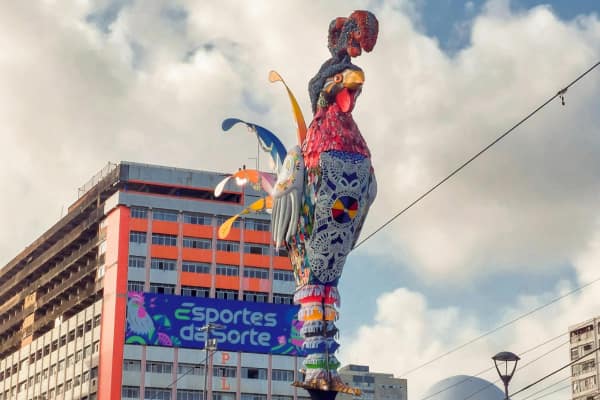
Another essential element is Frevo, a fast-paced music and dance style born in Pernambuco. Recognized by UNESCO as Intangible Cultural Heritage of Humanity, Frevo fills the streets with brass instruments, upbeat rhythms, and dancers performing acrobatic steps with small umbrellas. Experiencing Frevo live is one of the unforgettable moments of Olinda Carnival.
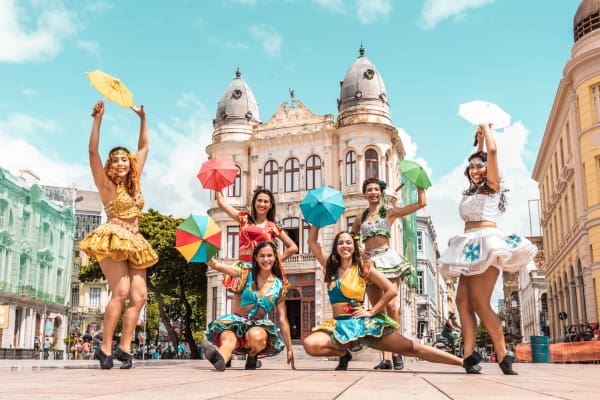
What really sets this Carnival apart, however, is its inclusive and democratic spirit. Locals and tourists from all over the world mingle together, climbing Olinda’s hills, following blocos (street bands), and dancing side by side. It’s a celebration where culture, music, and people blend into one joyful, contagious atmosphere. Watch a video:
Where does the Olinda Carnival take place?
Olinda Carnival unfolds across the city’s Historic Center, a UNESCO World Heritage Site known for its colorful colonial houses, narrow streets, and steep stone-paved hills. The architecture and geography of the city give the festival a unique charm, as music echoes through winding alleys filled with costumes, confetti, and giant puppets.
The main points of the celebration include:
- Alto da Sé: The highest point in the city, offering panoramic views of Olinda and Recife. It’s one of the liveliest spots, where several blocos gather.
- Praça do Carmo: A central square that becomes a massive stage for bands, parades, and spontaneous parties.
- Rua do Amparo: A picturesque street in the historic district, lined with colonial mansions and bars, that turns into a hub of music and dance during Carnival.
Unlike other Brazilian Carnivals that concentrate their events in specific venues, in Olinda the entire city becomes the stage. Every corner, from small alleys to large squares, transforms into part of the party, making the experience immersive and unforgettable.
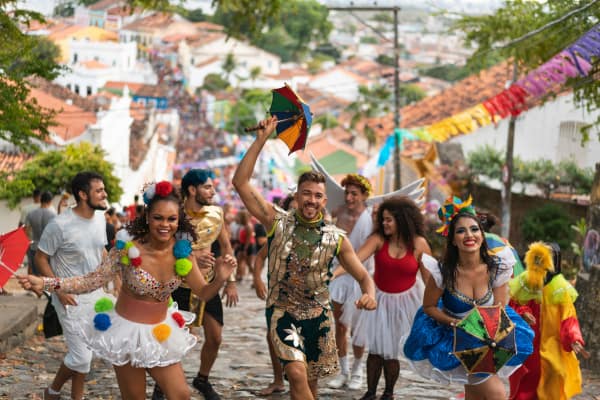
How to join the celebration
One of the best things about Olinda Carnival is that it is completely free and open to everyone. There are no tickets or “abadás” (special T-shirts used as passes in other Brazilian Carnivals like Salvador). Instead, all you have to do is step into the streets and follow the sound of the music. The blocos, street bands and parades, are scattered throughout the city, and anyone can join them.
The celebration starts early in the day, usually in the late morning and afternoon, with many blocos making their way through the Historic Center. The energy continues into the evening, with parties and music lasting late into the night. Whether you prefer dancing in the sunshine or celebrating under the stars, Olinda Carnival has something for everyone.
If you want to catch the famous Giant Puppets of Olinda, the best spots are around Alto da Sé and Praça do Carmo, where many of the parades pass by. Arrive early, as these areas get crowded quickly when the puppets begin their colorful march through the narrow streets.
Read about other Carnivals in Brazil:
What to wear at Olinda Carnival
Since Olinda Carnival takes place in the middle of the Brazilian summer, the most important rule is to wear light and comfortable clothing. Temperatures are high, and you’ll be walking and dancing for hours, often under the sun.
While costumes are not mandatory, many locals and visitors embrace the spirit of Carnival by dressing up in funny, creative, or colorful outfits. From superheroes and cartoon characters to quirky handmade costumes, anything goes! Even a small accessory, like a glitter mask or a hat, will make you feel part of the festive atmosphere.
Footwear is another key point: the Historic Center of Olinda is full of cobblestone streets and steep hills, so comfortable shoes or sneakers are essential. Avoid flip-flops, as they can be slippery and uncomfortable for long hours of walking and dancing.
Safety tips for tourists in Olinda Carnival
Like any major street festival, Olinda Carnival is lively, crowded, and full of energy—which makes it amazing, but also requires some basic precautions. To make sure you enjoy the party safely:
- Avoid carrying valuables such as jewelry, expensive cameras, or large amounts of cash. Instead, bring only what you need for the day.
- Use a money belt or anti-theft pouch worn under your clothes to keep your essentials like phone, ID, and money secure.
- Be extra attentive in crowded areas, where pickpocketing can happen.
- The hot weather and long hours outdoors make it essential to stay hydrated and apply sunscreen regularly. Many stalls sell water, coconut water, and fresh juices, take advantage of them.
- Whenever possible, enjoy the festivities in groups. It’s not only safer but also more fun to share the experience with friends or fellow travelers.
By following these simple tips, you’ll be free to focus on the music, colors, and incredible energy of the Olinda Carnival.
What to eat during Carnival in Olinda
Carnival in Olinda isn’t just about music and dancing—it’s also a chance to taste some of the best street food in Brazil. As you walk through the Historic Center, you’ll find plenty of stalls and vendors offering quick, delicious bites that keep you fueled for the celebration.
Popular options include:
- Tapioca: a crepe made from cassava flour, filled with cheese, coconut, or even savory meats.
- Caldinho: small cups of hot broth, often made from beans, seafood, or sun-dried meat; perfect for recharging your energy.
- Pastel: deep-fried pastries filled with cheese, beef, or chicken..
Most food stands are located around Praça do Carmo, Alto da Sé, and Rua do Amparo, where the crowds gather and the blocos pass by. Eating at these local stalls is part of the authentic Olinda Carnival experience, you’ll dance, eat, and celebrate like a local.
Day trips and activities before/after Carnival
While the Olinda Carnival is the highlight of February in Pernambuco, you can make the most of your trip by exploring nearby destinations before or after the festivities:
- Recife: Just 7 km away, Recife is a cultural hub with attractions like Marco Zero Square, the historic neighborhoods of Recife Antigo, and the world-renowned Instituto Ricardo Brennand, home to one of the most important collections of medieval art in the Americas. Book your tour of Olinda and Recife!
- Porto de Galinhas: About one hour from Recife, this beach paradise is famous for its natural pools of crystal-clear water, colorful fish, and white sandy beaches. It’s the perfect spot to relax after the high-energy Carnival days.
- Itamaracá Island: Known for its historic Forte Orange and natural pools, Itamaracá offers a quieter and more cultural experience, ideal for combining history with stunning seaside landscapes.
Check our complete guides to Northeast Brazil, Pernambuco, and Recife for more inspiration.
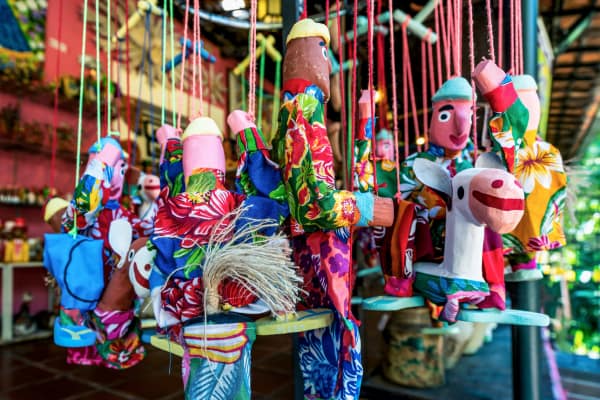
The Olinda Carnival is often described as the most authentic and democratic carnival in Brazil. Unlike Rio or Salvador, where parades are ticketed or concentrated in large arenas, Olinda’s celebration takes over the entire historic city, bringing together locals and visitors in a true street party.
It’s a mix of music, dance, art, and history, where frevo rhythms, colorful costumes, and the famous Bonecos Gigantes fill the cobblestone streets with joy.
For travelers seeking not just a party, but a cultural immersion into Brazil’s traditions, Olinda Carnival is an unforgettable experience, vibrant, inclusive, and absolutely unique.

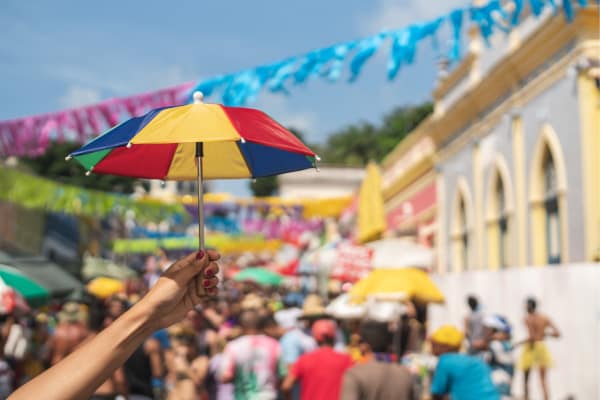



Opa, pessoal! Vi o Wim444 por aí. Queria saber se a plataforma é fácil de usar e se o suporte ao cliente é bom. Alguém pode me ajudar? wim444
Saved as a favorite, I really like your blog!